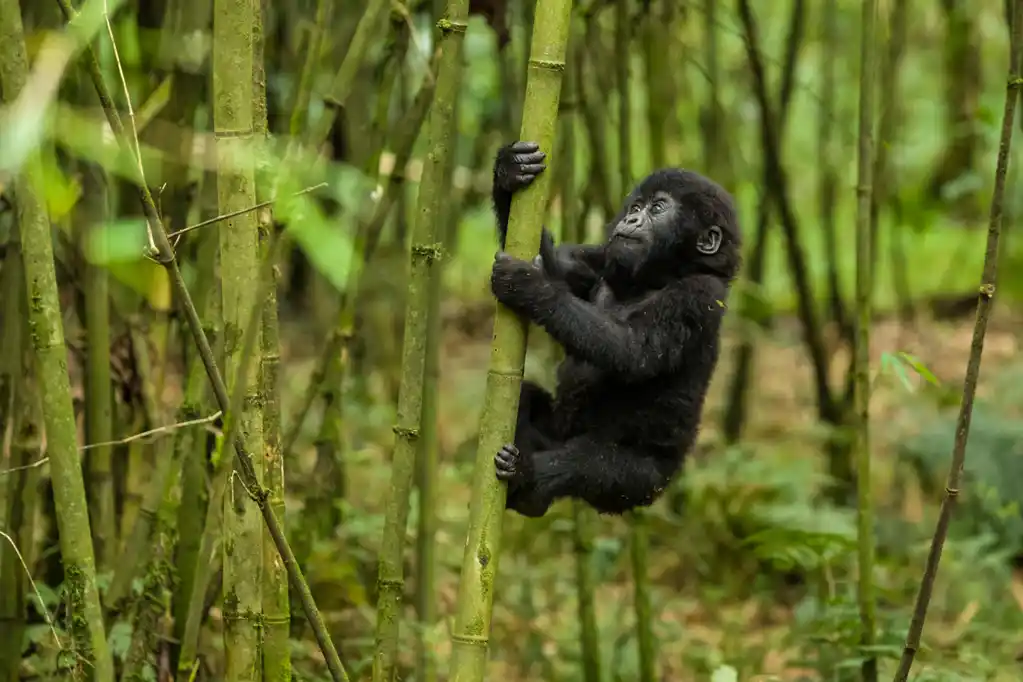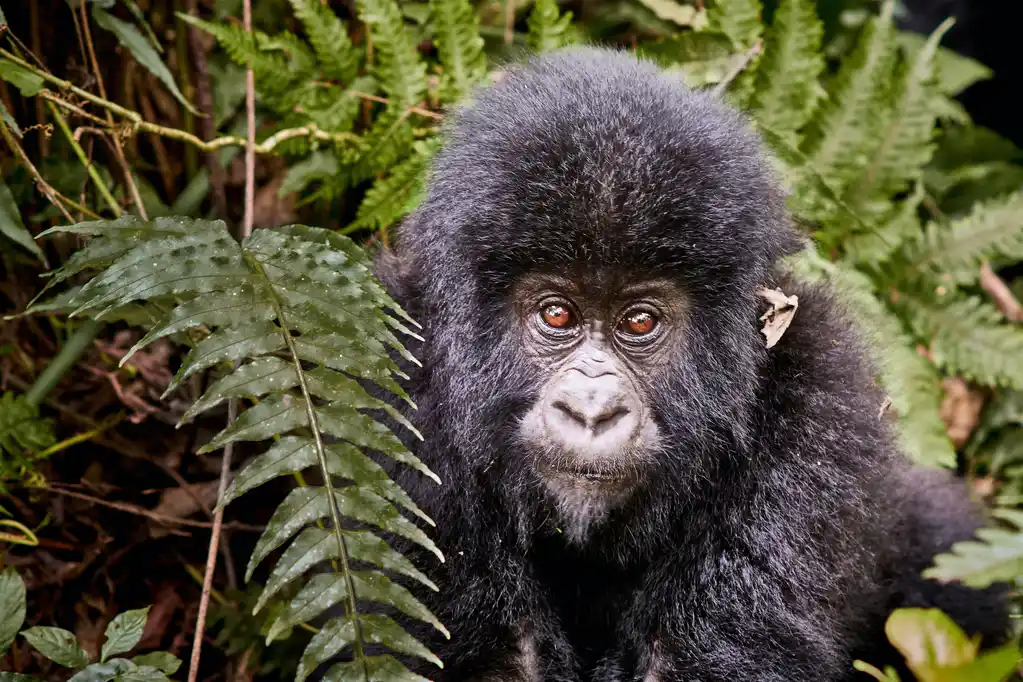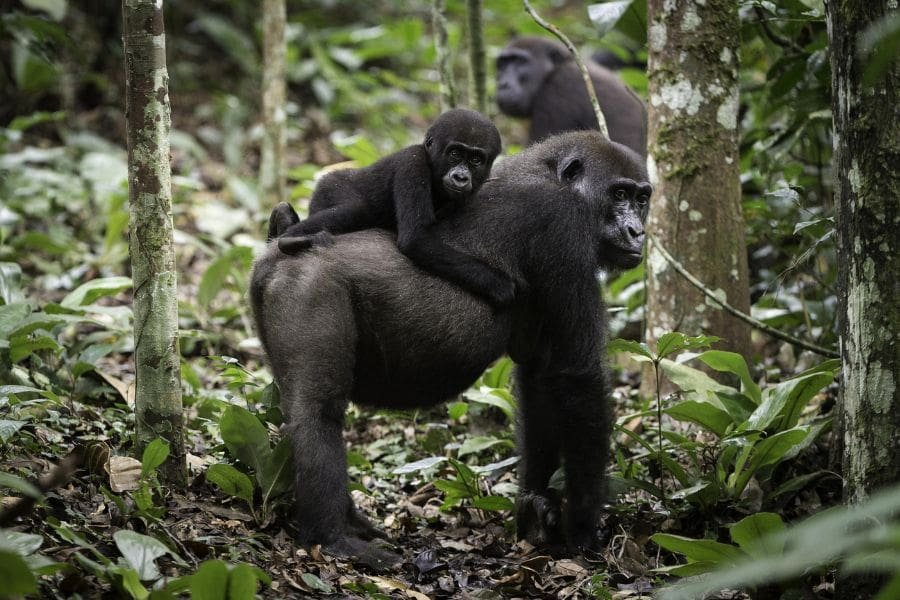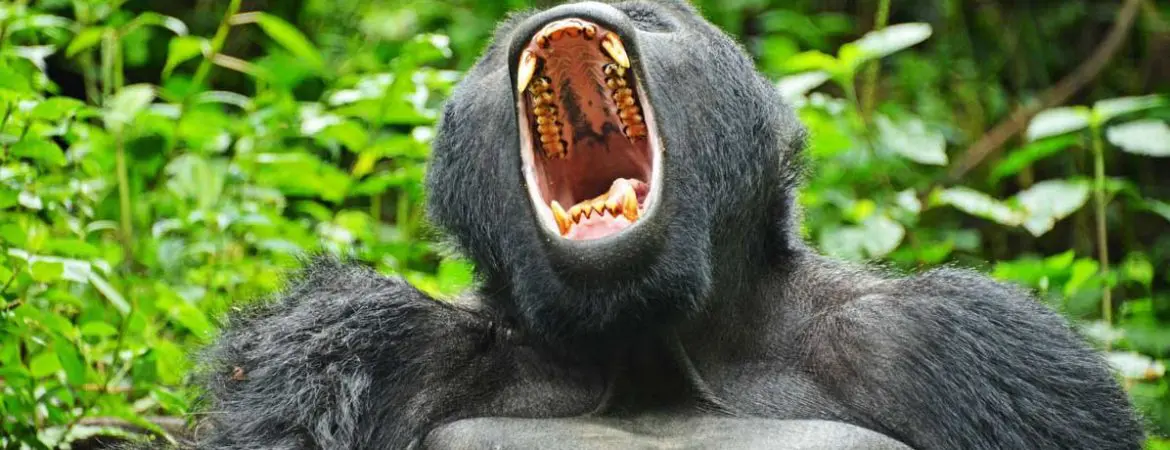- CONTACT US
- info@oruganosafaris.com
- +256-701-230-309
Gorilla trekking is a rare and unbeatable Africa safari which lets you see gorillas in their natural forest habitats. Wondering where to see gorillas in Africa? These amazing animals live in Central and Sub-Saharan Africa, in countries like Uganda, Rwanda, Democratic Republic of Congo (DRC), Congo-Brazzaville, Cameroon, Central African Republic (CAR), Gabon, Equatorial Guinea, and Angola. Gorillas live in different forests such as mountain forests, lowland rainforests, and bamboo forests.
There are two main species of gorillas: the eastern gorilla (Gorilla beringei) and the western gorilla (Gorilla gorilla). The eastern gorilla has two subspecies—mountain gorilla (Gorilla beringei beringei) and eastern lowland gorilla (Gorilla beringei graueri), while the western gorilla also has two subspecies—western lowland gorilla (Gorilla gorilla gorilla) and the rare Cross River gorilla (Gorilla gorilla diehli).
Sadly, all gorilla subspecies are endangered due to threats like deforestation, poaching, and disease. By going on a gorilla trek, you not only enjoy a unique wildlife adventure but also help protect them, as your permit fees support conservation and local communities.
The best places for a gorilla trekking safari often depend on your budget and how adventurous you are. Most travelers choose to see mountain gorillas in Uganda or Rwanda, both of which are safe, welcoming, and offer well-developed tourism services. For those looking for a wilder, off-the-beaten-path experience, there are also more remote destinations where you can see eastern lowland gorillas or western lowland gorillas, such as in the Democratic Republic of Congo (DRC), Republic of Congo (Congo-Brazzaville), and Central African Republic (CAR). No matter where you go, seeing gorillas in the wild is an unforgettable and deeply moving experience—one of the greatest wildlife encounters in all of Africa.
Uganda is a lush paradise of rainforests, grasslands, lakes, and rivers—often called the “Pearl of Africa.” It is home to nearly half of the world’s mountain gorillas, making it one of the best and most accessible places to see these rare animals in the wild. Uganda is also home to over 20 other primate species, including chimpanzees and golden monkeys, which you can trek as well.
It’s considered the most affordable destination in the world for mountain gorilla trekking. Plus, Uganda easily combines with a safari in Tanzania’s Serengeti—many travelers add a 3- or 4-day gorilla trek to their itinerary, with daily flights between Entebbe and Tanzania available.

The heart of gorilla trekking in Uganda is Bwindi Impenetrable National Park, home to about 500 mountain gorillas, nearly half of the world’s remaining population. Over 25 gorilla families have been habituated for tourism, and treks are led by expert rangers and trackers.
Bwindi lives up to its name—the forest is dense, and some hikes can be quite challenging, but several gorilla groups are relatively easier to reach. One major advantage of trekking in Uganda over Rwanda is the lower cost of permits. The gorilla permits in Uganda costs US$800 for foreign non-residents, US$700 for foreign residents, US$500 for other African passport holders and US$80 for East African citizens.
Uganda also offers a wide range of affordable accommodations and enough attractions to easily fill a two-week itinerary, from wildlife safaris to cultural experiences.
For a deeper gorilla encounter, Bwindi offers a Gorilla Habituation Experience, where you spend up to four hours with a semi-habituated gorilla group. These treks are more unpredictable but incredibly rewarding, giving you a behind-the-scenes look at how gorillas slowly become accustomed to human presence. The cost for this unique experience is US$1,500—the same as a standard one-hour trek in Rwanda.
Nestled in the Virunga Mountains along the borders of Rwanda and the Democratic Republic of Congo, Mgahinga Gorilla National Park offers another incredible spot for gorilla trekking. The park has only one habituated gorilla family, making permits highly sought after, but the experience is breathtaking.
The scenery—framed by volcanic peaks—is spectacular, and hikes here are less strenuous than those in Bwindi. Mgahinga’s gorilla family is also special for having three silverbacks, a rare sight in gorilla families. Permit prices here are the same as in Bwindi, but with fewer visitors, Mgahinga has a quieter, more intimate feel. The park also offers additional activities, including golden monkey trekking, birdwatching, cultural experiences, and challenging hikes to the mountain summits.
Gorilla trekking in Uganda is available year-round, but the dry seasons—from December to February and June to September—are the most popular. Trails are less muddy and trekking conditions more favorable. However, the rainy seasons can be a great alternative: gorillas are still active, trails are quieter, and it’s easier to secure gorilla permits.
Rwanda offers the most accessible gorilla trekking experience in Africa. It’s generally easier to reach Rwanda’s mountain gorillas compared to Uganda, making it a great option for travelers with limited time.
Volcanoes National Park, where the gorilla treks take place, is only about a three-hour drive from Kigali, Rwanda’s capital. For those on a tighter schedule or seeking luxury, private helicopter transfers from Kigali to the park can also be arranged.
Rwanda also pairs perfectly with a Masai Mara or Serengeti safari, and many travelers add it on as a short two- or three-day extension. There are daily flights from Kigali to Nairobi and the Serengeti, and the rainforest is just a two-and-a-half-hour drive from Kigali’s international airport.

Rwanda’s gorilla trekking happens in Volcanoes National Park, located in the country’s northwest corner.
This iconic park is perhaps Africa’s most famous gorilla trekking destination, thanks to its global exposure and its historic connection to renowned primatologist Dian Fossey, whose groundbreaking work was portrayed in the film Gorillas in the Mist.
The park protects Rwanda’s share of the Virunga Mountains, a chain of breathtaking volcanoes blanketed with rainforest and thick bamboo stands.
Twelve gorilla families are currently available for tracking here. Among them is the Susa group, which lives high on Mount Karisimbi and was famously studied by Fossey. Other groups stay lower on the slopes, making for easier treks—although, being wild animals, they often move to new locations daily.
One downside is the cost of permits, which are priced at US$1,500 for foreign non-residents. However, discounts are available: US$500 for foreign residents and other African passport holders, and US$200 for Rwandan and East African Community citizens.
With a growing number of high-end lodges near the park, Rwanda has earned a reputation as the “Botswana” of gorilla trekking—a top-tier, luxury destination that offers an unforgettable experience at a premium price. Because of this, it’s often chosen as a high-end add-on to safaris in Kenya or Tanzania.
While in Volcanoes National Park, it’s worth exploring more than just gorillas.
You can go golden monkey trekking, hike to Dian Fossey’s grave at the former Karisoke Research Center, or take on the challenging climb to the crater lake atop Mount Bisoke. If you plan your visit for September, you might get the chance to attend Kwita Izina, Rwanda’s annual baby gorilla naming ceremony, which draws thousands of visitors to Kinigi, the park’s headquarters.
Gorilla trekking is available year-round, but the dry seasons, from mid-December to early February and June to September, offer the most comfortable trekking conditions. That said, the rainy seasons also have their perks. Even in the rain, park rangers track the gorillas every day, so you’ll still have a good chance of seeing them—just be sure to pack waterproof gear, including a rain jacket, pants, and a warm hat.
The Democratic Republic of Congo (DRC) is the only country in Africa where you can see both mountain gorillas and eastern lowland gorillas, making it a unique destination for primate lovers. However, it’s important to be aware the country have experienced security challenges and political instability. Travelers should carefully monitor the situation, take necessary precautions, and always explore with experienced guides and reputable tour operators who prioritize safety.

Several habituated mountain gorilla groups live within Virunga National Park, but unfortunately, the park has been closed to tourists since March 2020. While the closure was initially due to the COVID-19 pandemic, ongoing security concerns have kept it closed, and it is unlikely to reopen in the near future.
For now, a more practical option is Kahuzi-Biega National Park, home to about 250 eastern lowland gorillas. This park is the only place in the world where you can track this rare gorilla subspecies, which is found nowhere else outside the DRC.
Kahuzi-Biega lies a short drive from the charming town of Bukavu, situated on the scenic shores of Lake Kivu. Bukavu offers several comfortable accommodations, including historic colonial mansions. Compared to the more popular gorilla destinations in Uganda and Rwanda, Kahuzi-Biega is less visited and offers a more adventurous, off-the-beaten-path experience. Gorilla permits here are also more affordable, costing around US$400.
It is important to remember that the DRC remains a volatile country in some regions, especially near the eastern parks. Visitors should keep a close eye on the security situation and always travel with organized tours that prioritize safety.
Similar to neighboring Rwanda and Uganda, the best time to visit the DRC for gorilla trekking is during the drier months of December to February and June to September, when the trails are more accessible.
Distinct from its larger and more volatile neighbor, the Democratic Republic of Congo, the Republic of Congo—also known as Congo-Brazzaville—is a relatively peaceful and quiet destination. It is the best place in Africa to see western lowland gorillas in their natural habitat.

The wild, dense rainforests of Odzala-Kokoua National Park in the northwest offer a rare chance to encounter habituated western lowland gorillas. Due to the park’s remote location, visiting here is costly, but it promises an exclusive and unforgettable experience. Trekking through pristine wilderness, guests enjoy small group tours and rustic luxury lodges that perfectly balance comfort with adventure.
The ideal time to visit is during the dry seasons, from June to September and December to February. These months increase your chances of spotting gorillas as they gather fruit, and the dry weather also makes the park’s access roads less prone to flooding, ensuring smoother travel and better trekking conditions.

When considering all gorilla species, including both mountain gorillas and western and eastern lowland gorillas, DR Cong has the largest overall gorilla population in Africa. This is because the DRC is home to both mountain gorillas (in Virunga National Park) and the much larger population of eastern lowland gorillas (in Kahuzi-Biega National Park), as well as western lowland gorillas in other regions.
However, when focusing only on mountain gorillas, Uganda has the highest number, especially in Bwindi Impenetrable National Park.
No, gorillas don’t live in Tanzania. They only live in Uganda, Rwanda and Congo. Gorillas prefer highland tropical rainforests, and the Virunga conservation area is their main habitat.
Both Rwanda and Uganda are great places to see gorillas, each with its own advantages. Rwanda’s Volcanoes National Park is easier to reach and perfect if you have limited time, but gorilla permits there are more expensive, costing around US$1,500. Accommodation near the park tends to be high-end and pricier.
In contrast, Uganda’s Bwindi Impenetrable Forest offers more affordable gorilla permits—around US$700 for foreign visitors—and a wider range of accommodation options to fit different budgets. Bwindi also has a special Gorilla Habituation Experience, where you can spend up to four hours with a semi-habituated group for about US$1,500. For a quieter, less crowded trek, Uganda’s Mgahinga National Park has one habituated group, with permit prices similar to Bwindi’s.
So, Rwanda offers easier access but at a higher cost, while Uganda provides more affordable permits and accommodations along with unique gorilla experiences.
Meeting a gorilla face-to-face is an unforgettable experience. Their deep eyes seem to connect with you, making it one of the most amazing wildlife moments. Expect a one-hour visit with the gorillas in their forest home. Keep in mind, you’ll be trekking through heat, humidity, and insects for about 2 to 7 hours, so be prepared.
Absolutely. The money you pay for permits helps protect gorillas and their habitats, supports local communities, and keeps conservation efforts going strong. It also helps improve the experience for all visitors.
Gorillas are generally peaceful, quiet, and very social animals. Each group has its own personality, so your experience will vary. Sometimes they’ll be calm and still, other times playful and energetic with babies swinging from trees. Because every visit is unique, many people recommend trekking more than once and visiting different gorilla families if possible.
Gorillas, especially the younger ones, are curious and may come close or even reach out to you. Guides are always there to keep a safe distance. Occasionally, a gorilla might playfully charge, but guides will step in to protect both you and the gorillas. Always wear a mask since gorillas share 98% of our DNA and can catch human diseases like COVID-19 or the flu.
Gorillas are usually shy and avoid conflict. They only attack if they feel threatened or if visitors don’t follow the rules. Never run or make sudden moves near gorillas—slow and calm movements are key. Though rare, a gorilla bite can be very strong, with a bite force much greater than that of lions or crocodiles.

Ready to start your amazing gorilla adventure? We make planning easy and fun, helping you every step of the way.
Bwindi Impenetrable Forest Nkuringo Sector- Uganda
+256-701-230-309
info@oruganosafaris.com